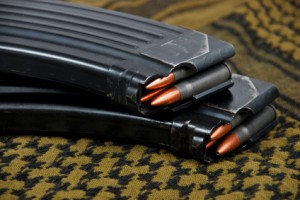When you think of combat load, a vision of a soldier saddled with dozens of magazines strapped to his chest may come to mind, and you’d be right. In the military, your combat load, or “loadout,” is a measure of the quantity and type of ammunition you carry on your person. The military goes so far as to specify standard loads (which are frequently ignored in favor of far more magazines); for example, a standard Army rifleman load for the M4 rifle is seven magazines of thirty rounds each, with one in the gun to make eight magazines total.
 What this means to you as a homeowner in light of self-defense is that you need to plan your ammunition needs carefully. If your idea of home defense is a revolver in the nightstand loaded with six rounds and the remainder of the ammunition safely locked away, you’ll most likely be in for a rude awakening. This is also no time for comments like “If I need more than six rounds, there is a problem.” Yes, there would be a problem; it’s called surprise, and it happens to law enforcement officers and soldiers every day.
What this means to you as a homeowner in light of self-defense is that you need to plan your ammunition needs carefully. If your idea of home defense is a revolver in the nightstand loaded with six rounds and the remainder of the ammunition safely locked away, you’ll most likely be in for a rude awakening. This is also no time for comments like “If I need more than six rounds, there is a problem.” Yes, there would be a problem; it’s called surprise, and it happens to law enforcement officers and soldiers every day.
When considering how much ammunition you need to carry, or in your case as a homeowner, keep on hand, you need to examine a few factors. Just as in the military, you need to look at things like expected engagements, resupply, and type of weapon. The reason why most infantry soldiers in the sandbox go out on patrols with as many as fourteen magazines (thirty rounds each) is because they expect to take and return heavy fire while simultaneously being out of easy resupply range. Such is the case in your home – with one exception. You as the homeowner need to consider reinforcements.
When you pick up the phone and dial 911, ask yourself how long it will take the police to reach you. In an urban setting, the time could be as little as a couple of minutes, while in a rural setting, it could be a half hour or more, sometimes far more depending on the remoteness of your retreat. In the latter case, you may have to prepare for a protracted engagement that could run the gamut from petty thieves to a highly targeted home invasion.
Planning Your Combat Load
Planning an effective combat load begins with commonality of weapons systems, ammunition, magazines, and magazine carriers to form an end-to-end solution that covers all bases. Having a really cool magazine carrier is no good if you have to carry magazines for five different weapons. Now is the time to standardize. You don’t have to get rid of your oddball guns, just don’t plan on using them for home defense.
The first area to look at is a common weapons system platform. This article isn’t meant to resurrect the great 9mm vs. .45 debate nor the .223 vs .308 debate – pick what works for you. Your combat load needs to account for at least one pistol and one rifle per person, so again, if you’re a die-hard 1911 fan or an M9 aficionado, pick whatever works for you. Ideally, if there are two adults in a given household, their rifles should have interchangeable magazines (your primary home defense rifle is magazine fed, right?). Even though the brand of the rifle might not be the same…or even the design, make sure the magazines and ammunition are the same! A prime example of two extremely disparate rifles that use the same magazine and ammunition are the Kel-Tec SU16 and any AR platform rifle. They are totally different guns – they don’t even look anything alike, yet they use the same magazines. Don’t feel like you need to equip everyone with a top-of-the-line $1300 AR-type rifle either; just ensure whatever you choose can handle common magazines.
The same rules apply in the case of pistols, yet in this realm pistols tend to have proprietary magazines that are not brand interchangeable. A prime example of a pistol that does, however, use versatile magazines is most any 9mm made by Glock – there are actually quite an impressive array of carbines and pistols not made by Glock that use Glock mags.
Commonality of ammunition goes hand in hand with commonality of magazines, obviously, but it should be stated that in the best case, what you shoot should be what is commonly available. To use an extreme example, if you set up a retreat and made sure that every rifle you had was chambered in .50 Beowulf, for example, you’d need to stock a lifetime of ammunition for that platform. This is a prime reason why you need to shoot what there is a healthy supply of – 9mm and .223 or 5.56 NATO – not so much from a ballistics standpoint, but from a resupply standpoint. Every police department and military unit has those calibers on hand in copious quantities, which means that in a societal collapse scenario, you too may have access to that type of ammo.
Keep Your Handgun Locked and Loaded, Ready For Instant Use – Without Fear Of An Accident!
Once you’ve settled on the type of ammunition and weapons platform, you need to think about how many magazines you should reasonably keep on hand for each one. Again, this will depend on how far away your backup is. When most people think about keeping loaded magazines on hand, the thought turns to old wives tales of magazine springs failing from being stored loaded. What most metallurgically challenged individuals fail to realize is that a magazine spring (or any spring, for that matter) is not affected by how much it is compressed or for how long. Spring steel’s lifetime is measured in cycles of expansion and contraction. A spring will eventually go bad from being cycled too many times – not from being compressed a single time and then kept in a drawer for a decade. Load your magazines without fear, and keep them loaded!
Theory aside, you really should have a minimum of three magazines immediately available to you for your home defense even in an urban setting. It’s no coincidence that most police officers across the nation carry three magazines – two on the belt, and one in the gun. This is a nice balance of firepower and portability. It goes without saying that if you live in a state where magazine capacity is limited by law, you will need more than three magazines. If your home defense weapon of choice is a 9mm pistol, with each magazine carrying fifteen rounds, then carry three of those for a total of forty-five rounds. This is a good and practical amount of ammunition that can easily be carried on your person. The same goes for three thirty-round magazines for an AR-type rifle – almost any adult can carry two rifle magazines in their pockets and one in the gun.
Past three magazines, however, and you need to start looking at a means of carrying these magazines in the event you might need to go on the move. This is not necessarily advocating that you need to have a chest rig with a dozen magazine pouches hanging on your coat rack, but you need to think about transport. There are many new and versatile tactical backpacks and computer bags that also double as ammo carriers, with pouches built in for common magazines.
You can still keep all your oddball calibers and neat weapons you own and have accumulated over the years, but consider your home defense weapons being the same caliber and using the same magazine so that everyone can resupply. Keep a quantity of loaded magazines on hand for each weapon and have a way to carry them, even if just from room to room, and you’ll go a long way to being prepared for whatever may come.
©2012 Off the Grid News
 Off The Grid News Better Ideas For Off The Grid Living
Off The Grid News Better Ideas For Off The Grid Living




